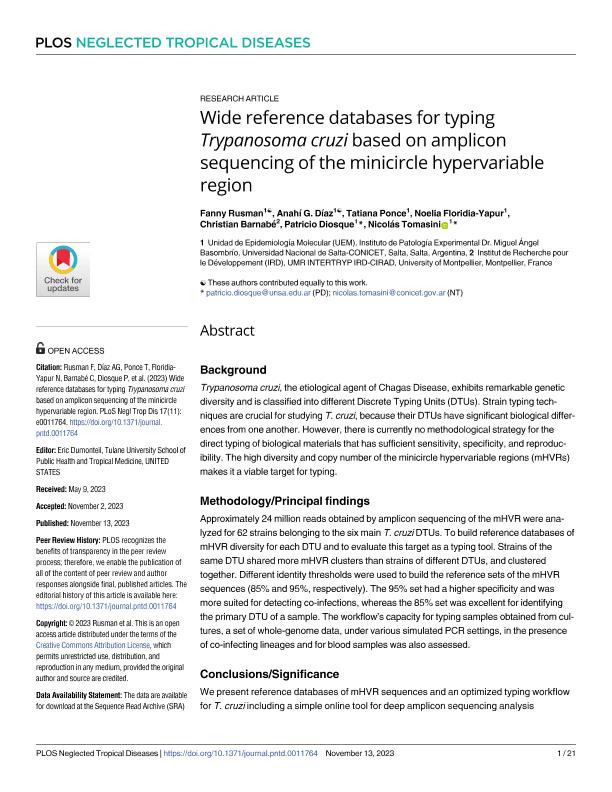Artículo
Wide reference databases for typing Trypanosoma cruzi based on amplicon sequencing of the minicircle hypervariable region
Rusman, Fanny ; Díaz, Anahí Guadalupe
; Díaz, Anahí Guadalupe ; Ponce, Tatiana Macarena Evelin
; Ponce, Tatiana Macarena Evelin ; Floridia Yapur, Noelia Aldana del Rosario
; Floridia Yapur, Noelia Aldana del Rosario ; Barnabé, Christian; Diosque, Patricio
; Barnabé, Christian; Diosque, Patricio ; Tomasini, Nicolás
; Tomasini, Nicolás
 ; Díaz, Anahí Guadalupe
; Díaz, Anahí Guadalupe ; Ponce, Tatiana Macarena Evelin
; Ponce, Tatiana Macarena Evelin ; Floridia Yapur, Noelia Aldana del Rosario
; Floridia Yapur, Noelia Aldana del Rosario ; Barnabé, Christian; Diosque, Patricio
; Barnabé, Christian; Diosque, Patricio ; Tomasini, Nicolás
; Tomasini, Nicolás
Fecha de publicación:
11/2023
Editorial:
Public Library of Science
Revista:
Neglected Tropical Diseases
ISSN:
1935-2735
Idioma:
Inglés
Tipo de recurso:
Artículo publicado
Clasificación temática:
Resumen
Background: Trypanosoma cruzi, the etiological agent of Chagas Disease, exhibits remarkable genetic diversity and is classified into different Discrete Typing Units (DTUs). Strain typing techniques are crucial for studying T. cruzi, because their DTUs have significant biological differences from one another. However, there is currently no methodological strategy for the direct typing of biological materials that has sufficient sensitivity, specificity, and reproducibility. The high diversity and copy number of the minicircle hypervariable regions (mHVRs) makes it a viable target for typing. Methodology/Principal findings Approximately 24 million reads obtained by amplicon sequencing of the mHVR were analyzed for 62 strains belonging to the six main T. cruzi DTUs. To build reference databases of mHVR diversity for each DTU and to evaluate this target as a typing tool. Strains of the same DTU shared more mHVR clusters than strains of different DTUs, and clustered together. Different identity thresholds were used to build the reference sets of the mHVR sequences (85% and 95%, respectively). The 95% set had a higher specificity and was more suited for detecting co-infections, whereas the 85% set was excellent for identifying the primary DTU of a sample. The workflow’s capacity for typing samples obtained from cultures, a set of whole-genome data, under various simulated PCR settings, in the presence of co-infecting lineages and for blood samples was also assessed. Conclusions/Significance We present reference databases of mHVR sequences and an optimized typing workflow for T. cruzi including a simple online tool for deep amplicon sequencing analysis (https://ntomasini.github.io/cruzityping/). The results show that the workflow displays an equivalent resolution to that of the other typing methods. Owing to its specificity, sensitivity, relatively low cost, and simplicity, the proposed workflow could be an alternative for screening different types of samples.
Palabras clave:
Trypanosoma cruzi
,
mHVR
,
Kinetoplast
Archivos asociados
Licencia
Identificadores
Colecciones
Articulos(IPE)
Articulos de INST.DE PATOLOGIA EXPERIMENTAL
Articulos de INST.DE PATOLOGIA EXPERIMENTAL
Citación
Rusman, Fanny; Díaz, Anahí Guadalupe; Ponce, Tatiana Macarena Evelin; Floridia Yapur, Noelia Aldana del Rosario; Barnabé, Christian; et al.; Wide reference databases for typing Trypanosoma cruzi based on amplicon sequencing of the minicircle hypervariable region; Public Library of Science; Neglected Tropical Diseases; 17; 11; 11-2023; 1-21
Compartir
Altmétricas



